Ovenbird
- December 17, 2023
- 0 comment
The Ovenbird (Seiurus aurocapilla) is a small songbird of the New World warbler family (Parulidae). This migratory bird breeds in eastern North America and winters in Central America, many Caribbean islands, Florida and northern Venezuela.
Physical Appearance
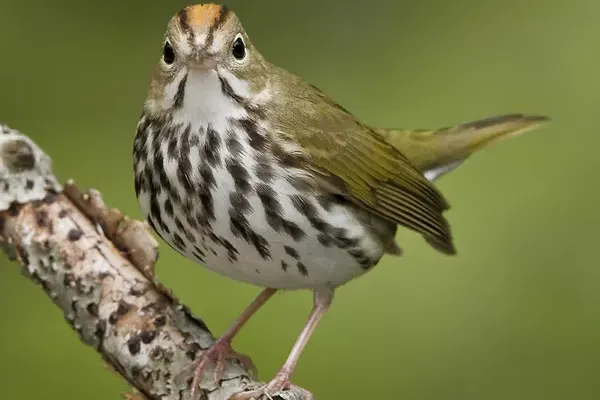
Ovenbird
- Lifespan: 5-7 years
- Habitat: Deciduous or mixed woodlands, especially those with a thick underbrush.
- Diet: Insects, Spiders and other invertebrates Also eats berries and seeds
- Size: 14-16.5 cm
- Weight: 17-23 grams
- Wingspan: 23-25 cm
- Conservation Status: Least Concern
- Population Trend: Population Stable
This species is named for its unique nest, which is shaped like a Dutch oven or old-fashioned outdoor bread-baking oven, with a domed roof and a side entrance. The Ovenbird is known for its ground-nesting habits and its ability to walk on the forest floor, a behavior uncommon among warblers. Its plumage is primarily olive-brown with a bold, orange crown on its head, making it easily identifiable.
Species Type of Ovenbird
The Ovenbird (Seiurus aurocapilla) is a species of warbler. Specifically, it belongs to the family Parulidae, which includes various species of New World warblers. The Ovenbird is known for its distinctive characteristics, such as its unique nest structure and ground-nesting behavior, setting it apart within the broader category of warblers.
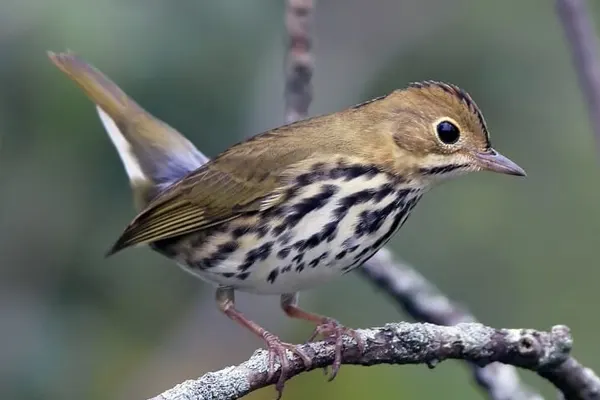
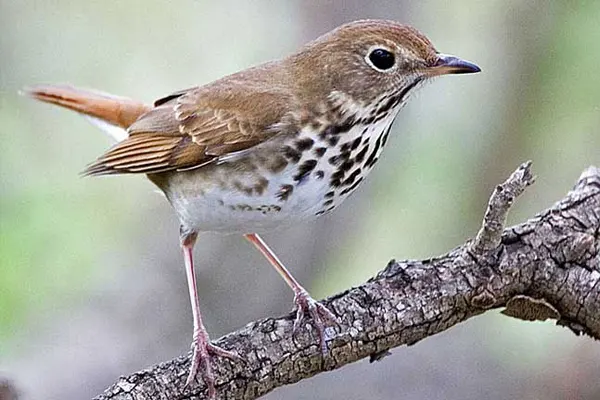
Males and females look alike. Immature birds have tawny fringes to the tertiary remiges and sometimes buff-tipped outer primary wing coverts. Most conspicuously, the olive-green tips of the crown feathers, which are hardly visible in adult birds, are far larger in extent in immatures and cover the orange crown-stripe almost or completely.
Feather Coloration of Ovenbird
The Ovenbird (Seiurus aurocapilla) typically exhibits a combination of muted and earthy feather colors. Its upperparts are primarily olive-brown, providing camouflage in the forested environments where it resides. The crown of the head is adorned with a bright, orange patch, adding a contrasting and distinctive feature to its appearance. The underparts of the Ovenbird are pale, often tinged with a yellowish hue, and the throat may have streaks. Overall, these subtle and well-camouflaged feather colors help the Ovenbird blend into its woodland habitat, providing effective concealment as it forages on the forest floor.

Female
- The olive green of their upperparts can vary in shade depending on the lighting and wear of the feathers.
- The white wing bars and eye ring are typically bright and clean, but they can become slightly stained or dulled over time.
- The buffy underparts can also vary in shade, with some females appearing more pale than others.
Male
- Yellow crown: A vibrant patch of yellow feathers on the top of the head, attracting attention and potentially signifying breeding status.
- Olive green nape: The color transitions from yellow to green on the back of the neck, creating a distinct border between the crown and the rest of the upperparts.
- Bold white eye ring: Encircles the eye, contrasting with the olive green and enhancing facial features.
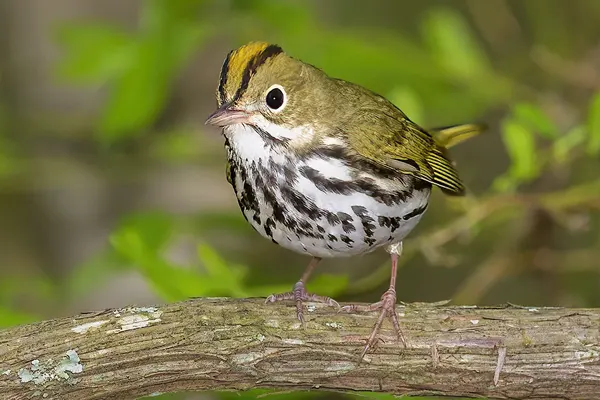
The combination of colors and patterns helps the Ovenbird blend in with its forest habitat, making it difficult for predators to spot. Additionally, the distinctive head markings play a role in territorial defense and mate selection.
Flight Characteristics of Ovenbird
The Ovenbird’s flight characteristics are well-adapted for its life in the forest habitat. Its short, low-level flights, agility, and hovering ability allow it to navigate the dense vegetation and forage for food efficiently. Additionally, its flight song plays an important role in territorial defense and mate attraction.
Flight Pattern
- Short, fluttering flights: Ovenbirds are not long-distance fliers and typically fly short distances within their forest habitat. Their wings are relatively short and rounded, suited for maneuvering through dense vegetation.
- Low to the ground: They tend to fly close to the forest floor, often just above the understory, rarely venturing higher into the canopy. This behavior helps them stay concealed from predators and allows them to forage for insects among the leaf litter.
- Sudden bursts of flight: When startled or threatened, Ovenbirds can burst into a flurry of rapid wing beats, propelling them quickly through the undergrowth.

Maneuverability
- Agile and acrobatic: Ovenbirds are highly maneuverable flyers, able to make sharp turns and sudden changes in direction with ease. This agility is crucial for navigating the dense forest environment and avoiding obstacles.
- Hovering: Although not for extended periods, Ovenbirds can briefly hover in mid-air while foraging for insects on leaves or branches.
Migration Patterns of Ovenbird
The Ovenbird’s migration is driven by the availability of food, changes in daylight, and environmental cues. These journeys involve impressive feats of navigation and endurance, with individuals covering thousands of miles during their annual round-trip migrations.
- Seasonal Migration: Ovenbirds are neotropical migrants, meaning they travel between breeding grounds in North America and wintering grounds in Central America and northern South America. They exhibit seasonal migration, with distinct movements during spring and fall.
- Spring Migration: During spring, usually around April and May, Ovenbirds migrate from their wintering grounds back to their breeding grounds in North America. They travel northward, often covering considerable distances.



- Breeding Grounds: Ovenbirds breed in deciduous and mixed woodlands across eastern North America, as far north as southern Canada and as far west as the Great Plains. They choose habitat with dense undergrowth for nesting.
- Fall Migration: In the fall, typically from September to October, Ovenbirds embark on their southward migration, returning to their wintering grounds in Central America and northern South America. They may use similar routes as they did in the spring.
- Wintering Grounds: During the winter, Ovenbirds can be found in various forested habitats, including tropical and subtropical forests, where they seek food resources in a milder climate.
Ovenbirds are long-distance migratory birds, traveling thousands of miles between their breeding grounds in North America and their wintering grounds in Central America and the Caribbean.
Habitat & Distribution of Ovenbird
The Ovenbird (Seiurus aurocapilla) is primarily found in deciduous and mixed woodlands, particularly in areas with a dense understory of vegetation. They thrive in mature forests as well as regenerating woodlands. This species shows a preference for habitats with a well-developed leaf litter and understory, which provides suitable foraging conditions. Ovenbirds are ground-nesting birds, and their nests are often located on the forest floor amid the leaf litter.
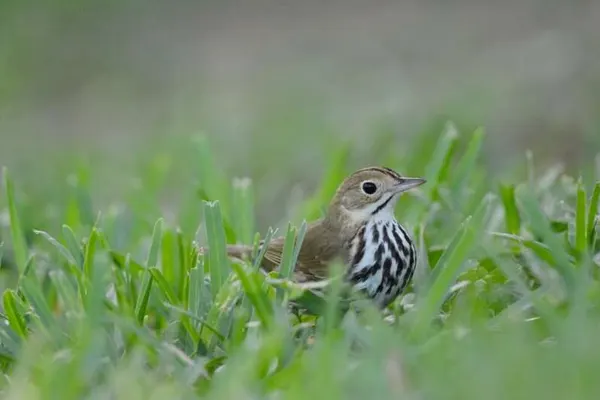
Distribution of Ovenbird: The Ovenbird’s breeding range extends across eastern North America, ranging from the southern parts of Canada to the northeastern and north-central United States, and as far west as the Great Plains. During the breeding season, they can be found in a variety of wooded habitats, including deciduous and mixed forests.
In the winter, Ovenbirds migrate to their non-breeding grounds. Their wintering range includes Central America and northern South America, where they inhabit various types of tropical and subtropical forests. The specific distribution during the non-breeding season can include countries such as Mexico, Honduras, Nicaragua, Costa Rica, Panama, Colombia, and Venezuela.
Behavioral Traits of Ovenbird
These various behaviors play a crucial role in the Ovenbird’s survival and success. Their vocalizations help them communicate with each other and defend their territories. Their foraging behavior allows them to find food in their forest habitat. Their nesting behavior ensures the continuation of their species. And their migration allows them to take advantage of seasonal changes in food availability and avoid harsh winter weather.
- Ground Foraging: Ovenbirds are primarily ground foragers, spending much of their time on the forest floor. They use their bill to flip away leaf litter and search for insects, spiders, and other invertebrates hidden beneath.
- Distinctive Nest Building: The Ovenbird constructs a unique, dome-shaped nest on the ground, often resembling an old-fashioned outdoor oven. This nest is built with leaves, twigs, and other vegetation, providing a secure and concealed space for nesting.
- Walking Gait: Unlike many warblers, Ovenbirds exhibit a distinctive walking gait on the ground. Their ability to walk rather than hop allows them to navigate the forest floor efficiently.
- Cryptic Plumage: The plumage of the Ovenbird is cryptic and provides excellent camouflage in its woodland habitat. The olive-brown upperparts and pale underparts, combined with streaks on the throat, help it blend into the surroundings and avoid detection by predators.
- Territorial Song: Male Ovenbirds are known for their loud and distinctive songs, which resemble the sound of an oven door creaking. They use these songs to establish and defend territories during the breeding season.
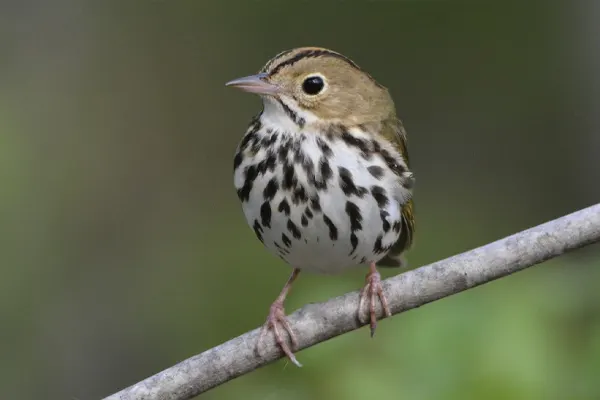
- Migratory Behavior: The Ovenbird is a neotropical migrant, undertaking long-distance migrations between its breeding grounds in North America and wintering grounds in Central America and northern South America. This migration is triggered by changes in daylight and environmental cues.
- Solitary Nature: While Ovenbirds may be found in proximity during the breeding season, they are generally solitary birds, especially during the non-breeding season when they migrate to wintering grounds.
These behavioral traits reflect the Ovenbird’s adaptations to its ecological niche, combining ground foraging, nest construction, and distinctive vocalizations to thrive in diverse habitats throughout its annual life cycle.
Role in Ecosystem of Ovenbird
The Ovenbird plays a vital role in the intricate web of life within the forest ecosystem. Its presence contributes to the health and balance of the environment, benefiting countless other species and ensuring the long-term sustainability of the forest community.
- Insect Control: Ovenbirds are primarily insectivores, and a significant portion of their diet consists of insects, spiders, and other invertebrates. By foraging on the forest floor, they help control insect populations, playing a role in maintaining the balance of the ecosystem.
- Seed Dispersal: While not the primary focus of their diet, Ovenbirds may occasionally consume fruits and berries. In the process, they can aid in seed dispersal, helping to propagate plant species within their habitat.
- Nesting Site Impact: The Ovenbird’s ground-nesting behavior and the unique structure of its nest contribute to the recycling of organic material on the forest floor. As the nest decomposes over time, it adds nutrients to the soil, influencing the local microenvironment.
- Prey for Predators: Ovenbirds serve as a food source for various predators within their ecosystem. This includes avian predators, mammals, and reptiles, contributing to the intricate web of trophic interactions.
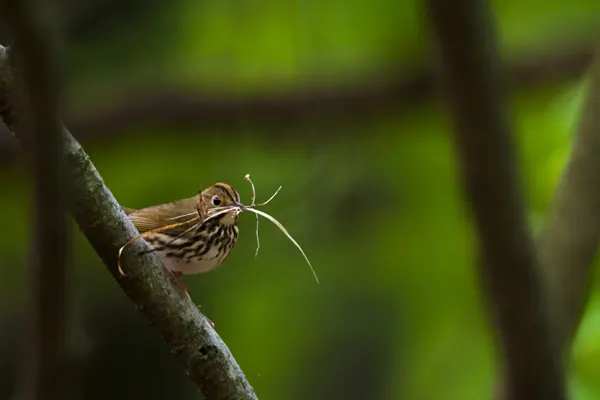
- Biodiversity Indicator: The presence and population trends of Ovenbirds can serve as indicators of the health and diversity of the forest ecosystems they inhabit. Changes in their numbers may reflect alterations in habitat quality and overall ecosystem conditions.
- Role in Forest Succession: Ovenbirds prefer habitats with a dense understory. By favoring such environments, they can influence the successional dynamics of forests. Their presence may contribute to the regeneration of woodlands and the maintenance of biodiversity in different stages of forest development.
- Behavioral Interactions: The Ovenbird’s territorial behavior and distinctive song contribute to the complex behavioral interactions within avian communities. The songs play a role in establishing and defending territories during the breeding season.
The Ovenbird, like many bird species, is an integral part of its ecosystem, influencing ecological processes through its feeding habits, nesting behavior, and interactions with other species. The conservation of Ovenbirds and their habitats is crucial for maintaining the overall health and balance of the ecosystems they inhabit.
Dietary Habits of Ovenbird
The Ovenbird’s dietary habits are adapted to its ground-foraging lifestyle in wooded habitats. Their reliance on insects and their ability to exploit the resources found in the leaf litter contribute to their role in controlling insect populations and maintaining the ecological balance in their ecosystems.
- Insectivorous Diet: The majority of the Ovenbird’s diet consists of insects, spiders, and other small invertebrates. They feed on a variety of arthropods found on the forest floor, including beetles, ants, caterpillars, and other terrestrial insects.
- Ground Foraging: Ovenbirds are ground foragers, meaning they search for food on the forest floor. They use their bill to flip away leaf litter, exposing hidden insects and invertebrates. This behavior is facilitated by their ability to walk on the ground rather than hop.
- Leaf Litter and Understory Feeding: Their preferred foraging habitat includes areas with a dense leaf litter and understory vegetation. The Ovenbird’s cryptic plumage helps it blend into this environment, making it effective at locating and capturing prey.
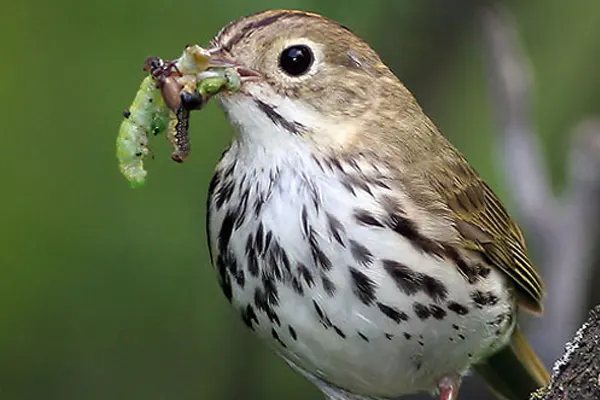

- Occasional Fruit Consumption: While insects make up the majority of their diet, Ovenbirds may occasionally consume fruits and berries, especially during periods when insect prey is less abundant. However, fruit consumption is not a primary aspect of their feeding behavior.
- Feeding Techniques: The Ovenbird employs a combination of gleaning and probing techniques to capture its prey. Gleaning involves picking insects directly from leaves and other surfaces, while probing involves inserting the bill into crevices to extract hidden prey.
- Seasonal Variation: The Ovenbird’s diet may show seasonal variation, with a higher reliance on certain types of insects during the breeding season when protein-rich food is crucial for the growth and development of chicks.
The Ovenbird’s diet plays a key role in its survival and success. Their ability to efficiently capture and consume insects helps them maintain their energy levels and meet the nutritional demands of breeding and migration. Understanding their dietary habits is crucial for conservation efforts, as it helps us identify potential threats to their food sources and develop strategies to protect their habitat.
Interesting Facts of Ovenbird
These are just a few of the many fascinating facts about the Ovenbird. This remarkable creature continues to captivate naturalists and bird enthusiasts with its unique behavior, complex ecology, and melodious song.
- Distinctive Song: The Ovenbird is known for its loud and distinctive song, which has been described as sounding like “teacher, teacher, teacher.” This song is often used by birdwatchers to identify the presence of Ovenbirds in their habitat.
- Nesting Behavior: The Ovenbird gets its name from the unique nest it constructs, which resembles a Dutch oven or an old-fashioned outdoor bread-baking oven. The nest is built on the ground, with a domed roof and a side entrance.
- Ground-Nesting Warbler: Unlike many warbler species that nest in trees or shrubs, the Ovenbird is a ground-nesting bird. This behavior is relatively uncommon among warblers and is well-adapted to its preference for habitats with a dense understory.
- Walking Gait: The Ovenbird has a distinctive walking gait on the ground, often compared to a miniature chicken. This is in contrast to the hopping behavior exhibited by many other warblers.
- Migratory Marvel: As a neotropical migrant, the Ovenbird undergoes impressive long-distance migrations between its breeding grounds in North America and wintering grounds in Central America and northern South America.

- Cryptic Plumage: The plumage of the Ovenbird is cryptic, providing effective camouflage in the leafy environments where it forages. The olive-brown coloration helps it blend into the forest floor.
- Territorial Behavior: During the breeding season, male Ovenbirds establish and defend territories through vocalizations and displays. The loud and repetitive song serves not only to attract mates but also to deter potential competitors.
- Adaptability: Ovenbirds are adaptable birds that can inhabit a variety of wooded environments, including mature forests and regenerating woodlands. Their ability to thrive in diverse habitats contributes to their widespread distribution.
These interesting facts showcase the Ovenbird’s unique characteristics, behaviors, and adaptations that make it a fascinating species within the avian world.
Nesting Habits of Ovenbird
The Ovenbird’s nesting habits are some of the most fascinating and complex among birds. Their unique domed nests, intricate construction, and shared parental responsibilities make them a captivating subject for observation and study.
- Ground Nesting: Ovenbirds are ground-nesting birds, meaning they construct their nests on the forest floor. The nest is typically situated amid the leaf litter, providing a concealed and well-camouflaged location.
- Nest Structure: The nest of the Ovenbird is a remarkable structure resembling a small oven, which explains the bird’s common name. It has a domed roof and a side entrance, creating a covered space that helps protect the eggs and chicks from the elements and potential predators.
- Materials Used: The Ovenbird constructs its nest using a variety of materials, including leaves, grasses, twigs, and other vegetation. The outer layer of the nest is often composed of dead leaves, which contributes to its camouflage.
- Location: Ovenbirds select nesting sites in areas with a dense understory, often near the base of shrubs or small trees. This choice of location provides additional cover and protection for the nest.
- Construction Process: The female Ovenbird is primarily responsible for nest construction. She builds the nest over the course of several days, weaving and arranging materials to create the distinctive domed structure.
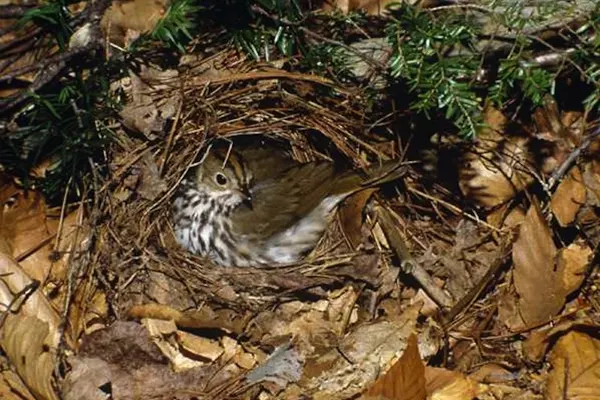

- Eggs and Incubation: The female lays a clutch of 3 to 6 eggs, which are white or pale with brown spots. She then incubates the eggs for about 12 to 14 days. During this period, the male may bring food to the female at the nest.
- Parental Care: Both parents participate in caring for the chicks once they hatch. They feed the chicks a diet of insects and other small invertebrates. The young birds fledge and leave the nest after approximately 10 days.
- Territorial Defense: Ovenbirds are known for their territorial behavior, especially during the nesting season. The male vigorously defends the nesting territory, often engaging in aggressive displays and vocalizations to deter intruders.
The unique ground-nesting behavior and the distinctiveness of the nest make the Ovenbird’s reproductive biology a fascinating aspect of its natural history. The ground-level nesting strategy provides advantages in terms of concealment but also poses challenges associated with predation risks.
Calls & Vocalizations of Ovenbird
The Ovenbird’s vocal repertoire is a crucial aspect of its behavior, serving various functions related to breeding, territoriality, and communication within social groups. Birdwatchers often rely on the distinctive song to identify the presence of Ovenbirds in their habitat.
- Song: The Ovenbird’s song is one of its most recognizable features. Described as a series of loud, ringing phrases, it often sounds like “teacher, teacher, teacher,” with each phrase getting slightly louder. The song is repetitive and serves various purposes, including establishing and defending territory, attracting mates, and communicating with other birds.
- Territorial Song: Male Ovenbirds use their song to establish and defend territories during the breeding season. The vigorous and repetitive nature of the song is intended to signal to other males that the territory is already claimed.
- Alarm Calls: In addition to its song, the Ovenbird has sharp and distinct alarm calls. These calls are used to alert nearby individuals to the presence of potential threats, such as predators. The alarm calls are often more abrupt and higher in pitch compared to the territorial song.
- Contact Calls: Ovenbirds may use softer contact calls to communicate with their mate or other members of their social group. These calls are less intense than the territorial song and are often used for more subtle communication.
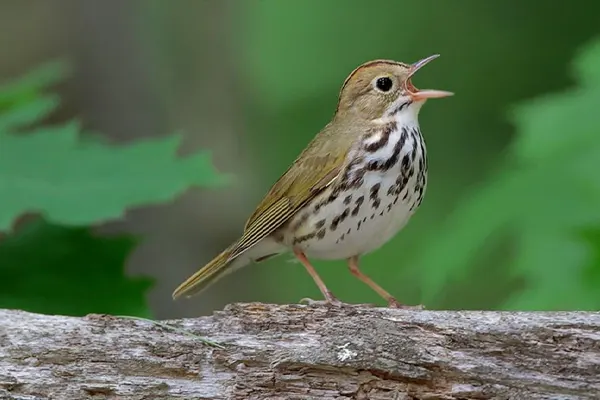
- Night Flight Calls: During migration, Ovenbirds engage in night flights, and they produce distinctive flight calls. These calls are used to maintain contact with other migrating individuals, allowing them to navigate and stay connected during their nocturnal journeys.
- Variation in Vocalizations: The Ovenbird’s vocalizations can vary geographically, with regional populations exhibiting subtle differences in their songs and calls. This variation can be influenced by factors such as local dialects and environmental conditions.
- Communication during Nesting: During the nesting season, both male and female Ovenbirds may use soft communication calls near the nest to coordinate activities and signal their presence to each other.
The Ovenbird possesses a diverse vocal repertoire that serves various purposes in communication and territorial defense.
Conservation Status of Ovenbird
The Ovenbird’s ecological significance encompasses its role in insect population control, seed dispersal, influence on forest succession, contribution to nutrient cycling, participation in predator-prey dynamics, support for biodiversity, and its value in ecotourism and education. Understanding and conserving the habitats that support Ovenbird populations contribute to the overall health and resilience of these ecosystems.
- Insect Population Control: As an insectivorous bird, the Ovenbird plays a role in controlling populations of insects, spiders, and other invertebrates. By foraging on the forest floor, it helps regulate the abundance of these arthropods, influencing the balance of the local ecosystem.
- Seed Dispersal: While not a primary fruit consumer, the Ovenbird may contribute to seed dispersal when it occasionally consumes fruits and berries. This can aid in the propagation of plant species within its habitat.
- Forest Succession: The Ovenbird’s preference for habitats with a dense understory contributes to forest succession. By favoring environments with specific vegetation characteristics, Ovenbirds may influence the composition and structure of woodlands over time.
- Indicator Species: Changes in the population and distribution of Ovenbirds can serve as indicators of broader environmental changes. Monitoring their presence and abundance can provide insights into the health and stability of the ecosystems they inhabit.

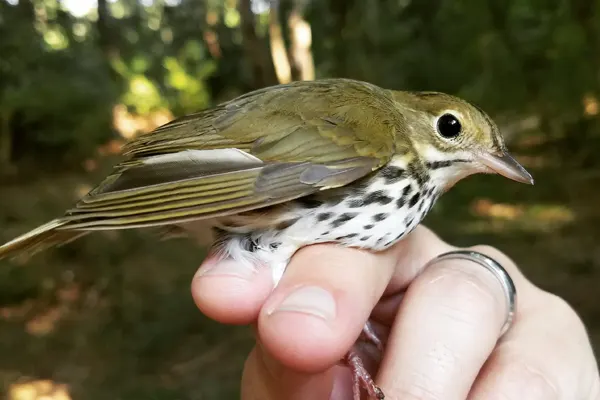
- Nutrient Cycling: The decomposition of the Ovenbird’s ground-level nest, composed of leaves and twigs, contributes to nutrient cycling on the forest floor. As the nest decomposes, it releases nutrients into the soil, influencing the local microenvironment.
- Predator-Prey Dynamics: As both prey and potential competitors for resources, Ovenbirds participate in the intricate web of predator-prey dynamics within their ecosystem. They serve as a food source for various predators, contributing to the overall biodiversity of the area.
- Biodiversity Support: The Ovenbird’s presence in diverse woodland habitats adds to the overall biodiversity of avian species. Its adaptability to different types of forests and its role as a migratory species contribute to the complexity and richness of bird communities.
- Ecotourism and Education: Ovenbirds, with their distinctive appearance, behavior, and vocalizations, contribute to ecotourism and educational opportunities. Birdwatchers and nature enthusiasts are drawn to observe and learn about these birds, fostering a greater appreciation for biodiversity and conservation.
The Ovenbird plays a crucial role in maintaining the intricate web of life within the forest ecosystem. Their ecological significance lies in their diverse contributions as predators, seed dispersers, indicator species, prey, pollinators, and contributors to soil health and forest structure. Understanding these contributions is essential for ensuring the long-term survival of this fascinating bird species and the overall health of the forest ecosystem.
Research and Ongoing Studies of Ovenbird
The Ovenbird’s conservation status is currently Least Concern, it’s important to remain vigilant and continue implementing conservation measures. Monitoring population trends, addressing potential threats, and ensuring the protection of their habitat are crucial for ensuring the long-term survival of this fascinating bird species.
- Wide Distribution: The Ovenbird has a broad and widespread distribution across eastern North America, where it inhabits various types of wooded environments. This wide range contributes to its overall resilience as a species.
- Adaptability: Ovenbirds are adaptable birds that can thrive in different forested habitats, including mature forests and regenerating woodlands. Their ability to utilize diverse environments enhances their capacity to withstand environmental changes.
- Migratory Behavior: The annual migration of Ovenbirds between breeding grounds in North America and wintering grounds in Central America and northern South America exposes them to different ecosystems, providing ecological flexibility.

- Wide Range: Ovenbirds have a large breeding range encompassing eastern North America and wintering grounds in Central America, the Caribbean, and parts of South America.
- Stable Population: Overall population trends appear to be stable, with no significant declines reported across the species’ range.
- Protected Habitats: Many Ovenbirds inhabit protected areas, such as national parks and forests, which provide them with secure breeding and wintering grounds.
Despite their “Least Concern” status, ongoing habitat loss, fragmentation, and other environmental changes can still pose localized threats to Ovenbird populations. Conservation efforts that focus on preserving and restoring suitable habitats, especially those with a well-developed understory and leaf litter, contribute to the overall well-being of Ovenbird populations and other associated species in their ecosystems.
Educational and Ecotourism of Ovenbird
The educational and ecotourism opportunities presented by the Ovenbird, we can foster a deeper understanding of this fascinating bird species, inspire conservation action, and promote sustainable practices for the benefit of both humans and nature.
- Birdwatching Tours: Ovenbirds are charismatic birds with distinctive behaviors and vocalizations. Birdwatching tours in their breeding grounds during the spring and summer provide enthusiasts with the chance to observe and appreciate these birds in their natural habitats. Guided tours may offer insights into their nesting behavior, foraging habits, and unique features.
- Educational Programs: Nature centers, wildlife reserves, and educational institutions can incorporate Ovenbirds into their programs to teach visitors about bird ecology, migration, and forest ecosystems. Interpretive signage, guided walks, and educational materials can enhance the understanding of the Ovenbird’s role in the environment.
- Citizen Science Initiatives: Involving the public in citizen science initiatives, such as bird monitoring or nest box programs, can provide educational opportunities. Participants can contribute to data collection while learning about Ovenbirds and the importance of conserving their habitats.
- Public Awareness Campaigns: The Ovenbird’s distinctive song and nesting habits make it an excellent focal point for public awareness campaigns. Educational materials, workshops, and events can raise awareness about the importance of preserving woodland habitats and the broader biodiversity they support.
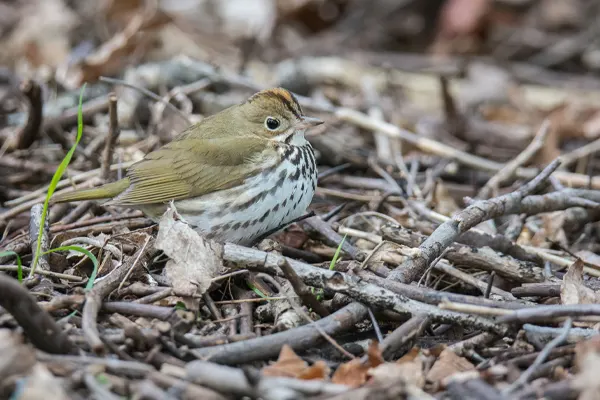
- Ecotourism Destinations: Areas known for supporting Ovenbird populations can become destinations for ecotourism. Guided tours, nature trails, and birdwatching events can attract visitors seeking to experience and appreciate the natural beauty of these habitats.
- Photography Opportunities: Ovenbirds’ distinctive appearance and behaviors make them appealing subjects for wildlife photographers. Photography workshops and tours can provide enthusiasts with opportunities to capture images of Ovenbirds in their natural settings.
- Research and Monitoring Programs: Opportunities for students and researchers to engage in field studies related to Ovenbirds can enhance educational experiences. Monitoring programs focusing on Ovenbirds can contribute valuable data to ongoing conservation efforts.
Leveraging the Ovenbird’s characteristics and ecological role, educational and ecotourism initiatives can contribute to a greater appreciation for biodiversity, foster conservation awareness, and provide meaningful experiences for individuals interested in the natural world.
Conclusion
The Ovenbird is a remarkable and captivating bird that plays a vital role in the forest ecosystem. From its unique domed nest and “teacher-teacher” song to its complex foraging behaviors and ecological significance, the Ovenbird continues to amaze and inspire naturalists, birders, and conservationists.
While its current conservation status may seem secure, ongoing threats like habitat loss and climate change demand continued vigilance and proactive measures. By understanding its ecological importance, supporting conservation efforts, and promoting educational and ecotourism opportunities, we can ensure the continued survival of this fascinating bird species and the healthy balance of the natural world it inhabits.
Overall, the Ovenbird serves as a powerful reminder of the interconnectedness of life and the importance of preserving biodiversity. By appreciating its unique characteristics, learning from its ecological contributions, and taking action to protect its environment, we can ensure a future where the Ovenbird’s beautiful song continues to echo through the forest, enriching our lives and inspiring future generations.






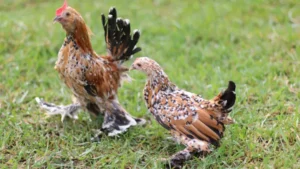
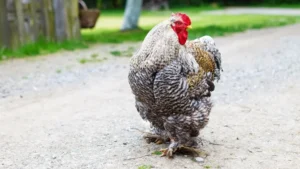
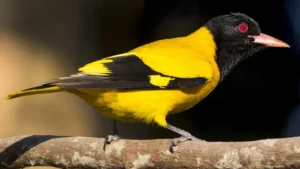
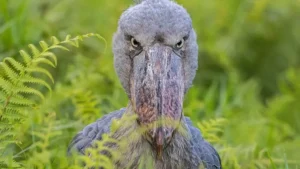
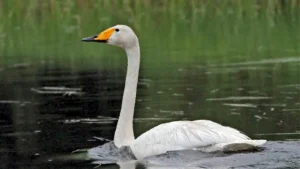

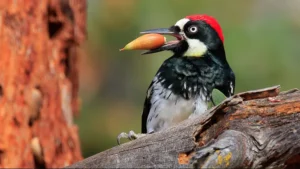
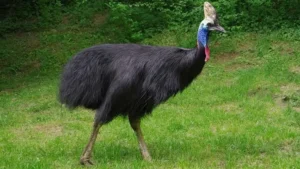
Leave your comment